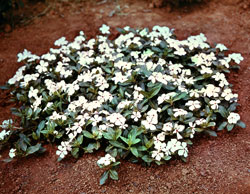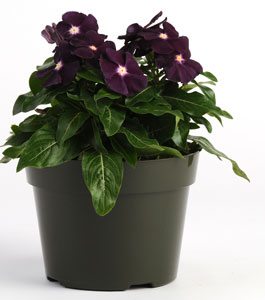8/27/2012
V for Vinca in 2012
Terry Howe

 Vinca Polka Dot from Park Seed (left) was the first vinca to win an AAS award in 1969. Jams ‘N Jellies is the last winner from PanAmerican Seed in 2012
Vinca Polka Dot from Park Seed (left) was the first vinca to win an AAS award in 1969. Jams ‘N Jellies is the last winner from PanAmerican Seed in 2012
In recognition of All-America Selections 80th anniversary, GrowerTalks is featuring a series of Culture Notes articles on previous AAS winners during 2012.
The weather this summer taxed plants to the extreme. Record-breaking heat. Minimal hydration. What’s a gardener to do? Many sought solutions to their garden woes by choosing varieties built to take the temps Mother Nature dished out. One of those stellar selections known for beating drought and heat is Vinca (
Catharanthus roseus).
Vinca is a low-maintenance variety that thrives in high heat conditions and, let’s face it, has a preference for being ignored by the watering can. Modern breeding of Vinca for annual flower color results in simple, single blooms in a widening color range. It meets the increasing demand for water-wise varieties and will survive municipal water restrictions or garden neglect.
This year, All-America Selections named PanAmerican Seed’s Vinca Jams ’N Jellies Blackberry as an AAS winner for its proven performance and unique dark coloring. The debut of Blackberry also creates a patriotic and popular vinca mix called Jams ’N Jellies American Pie.
Germination
Use a well-drained, disease-free, soilless medium with a pH of 5.8 and a medium initial nutrient charge (EC 0.75 mmhos/cm). Produce in 392, 288 or similar cell size plug trays. Vinca doesn’t like it cool, so keep soil temperature at 75 to 78F (24 to 25C) with no light required. Keep soil wet (level 4) during Stage 1 and maintain 95% relative humidity (RH) until the cotyledons emerge in 3-5 days.
Stage 2 soil temperature should be 70 to 72F (21 to 22C). Bring light levels up to 2,500 f.c. (26,900 Lux) and reduce soil moisture slightly (level 3 to 4) to allow the roots to penetrate into the media. Apply fertilizer at a less than 100 ppm N/less than 0.7 mS/cm EC from nitrate-form fertilizers with low phosphorous.
In Stage 3 maintain soil temperature and light conditions, but allow media to dry further until the surface becomes light brown (level 2) before watering. Keep the moisture to wet-dry cycle (moisture level 4 to 2). Increase fertilizer to 100 to 175 ppm N/0.7 to 1.2 mS/cm EC. Maintain medium pH of 5.8 and EC between 1.0 and 1.5 mS/cm (1:2 extraction).
Increase light up to 5,000 f.c. (53,800 Lux) if temperature can be controlled in Stage 4. Moisture and fertilizer remain the same as Stage 3. Growth regulators are not needed.
Growing on to finish
Use a well-drained, disease-free, soilless media with a pH of 5.8 and a medium initial nutrient charge (EC 0.75 mmhos/cm). Place night temperatures at 65 to 68F (18 to 20C) and day temps at 75F (24C) or above. Keep light as high as possible while maintaining optimal production temperatures. Avoid excessive media and foliage wetness, as these conditions are favorable for disease incidence. Incorporate a preventative fungicide program for Rhizoctonia, Botrytis and Phytophthora.
Starting one week after transplant, apply fertilizer at 225 to 300 ppm N/1.5 to 2.0 mS/cm once a week using predominately a nitrate-form fertilizer with low phosphorus and high potassium. Maintain the media EC at 1.5 to 2.0 mS/cm and pH at 5.8. For a constant fertilizer program, fertilizer can be applied at 175 to 225 ppm N/1.2 to 1.5 mS/cm while maintaining the above-recommended EC and pH ranges.
Crop scheduling sow to transplant
- 392, 288 or similar cell plug size—5 weeks
- Transplant to finish (606-packs or 306 premium packs): 5 to 6 weeks
- Transplant to finish [4.5-in. (10-cm)] pot: 6 to 7 weeks
- Total crop time from sow to finish: 10 to 12 weeks GT
Terry Howe is a Global Product Manager for PanAmerican Seed in West Chicago, Illinois.